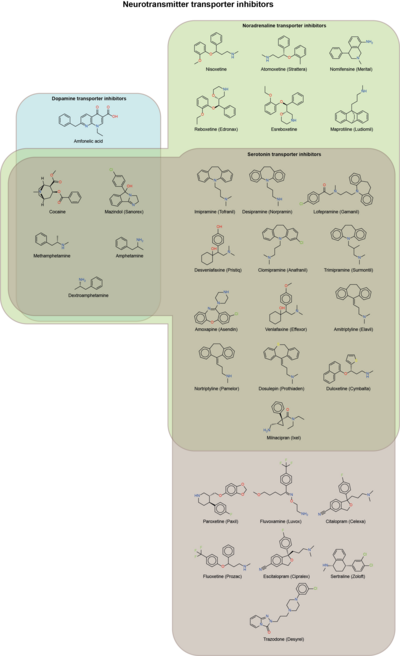| Revision as of 12:07, 28 March 2020 editPremeditated Chaos (talk | contribs)Autopatrolled, Administrators127,857 edits →See also: +List of adrenergic drugs← Previous edit |
Latest revision as of 15:01, 12 December 2024 edit undoCitation bot (talk | contribs)Bots5,446,739 edits Added doi-access. | Use this bot. Report bugs. | Suggested by Dominic3203 | Category:CS1 maint: unflagged free DOI | #UCB_Category 3/10 |
| (21 intermediate revisions by 17 users not shown) |
| Line 1: |
Line 1: |
|
|
{{Short description|Class of drug}} |
|
{{Infobox drug class |
|
{{Infobox drug class |
|
| Image = |
|
| Image = |
| Line 20: |
Line 21: |
|
| MeshID = D018759 |
|
| MeshID = D018759 |
|
}} |
|
}} |
|
]]] |
|
]]] |
|
]]] |
|
]]] |
|
|
|
|
|
A '''norepinephrine reuptake inhibitor''' ('''NRI''', '''NERI''') or '''Noradrenaline reuptake inhibitor''' or '''adrenergic reuptake inhibitor''' ('''ARI'''), is a type of ] that acts as a ] for the ]s ] (noradrenaline) and ] (adrenaline) by blocking the ] of the ] (NET). This in turn leads to increased ] ]s of norepinephrine and epinephrine and therefore can increase ] ]. |
|
A '''norepinephrine reuptake inhibitor''' ('''NRI''', '''NERI''') or '''noradrenaline reuptake inhibitor''' or '''adrenergic reuptake inhibitor''' ('''ARI'''), is a type of ] that acts as a ] for the ]s ] (noradrenaline) and ] (adrenaline) by blocking the ] of the ] (NET). This in turn leads to increased ] ]s of norepinephrine and epinephrine and therefore can increase ] ]. |
|
|
|
|
|
|
== Medical use == |
|
NRIs are commonly used in the treatment of conditions like ] and ] due to their ] effects and in ] due to their ] effects. They are also frequently used as ]s for the treatment of ], ] and ]. Additionally, many ] such as ] and ] possess NRI activity, though it is important to mention that NRIs without combined ] (DRI) properties are not significantly rewarding and hence are considered to have a negligible ].<ref name="pmid15283948">{{cite journal |vauthors=Wee S, Woolverton WL | title = Evaluation of the reinforcing effects of atomoxetine in monkeys: comparison to methylphenidate and desipramine | journal = Drug and Alcohol Dependence | volume = 75 | issue = 3 | pages = 271–6 |date=September 2004 | pmid = 15283948 | doi = 10.1016/j.drugalcdep.2004.03.010 }}</ref><ref name="pmid15526000">{{cite journal |vauthors=Gasior M, Bergman J, Kallman MJ, Paronis CA | title = Evaluation of the reinforcing effects of monoamine reuptake inhibitors under a concurrent schedule of food and i.v. drug delivery in rhesus monkeys | journal = Neuropsychopharmacology | volume = 30 | issue = 4 | pages = 758–64 |date=April 2005 | pmid = 15526000 | doi = 10.1038/sj.npp.1300593 }}</ref> However, norepinephrine has been implicated as acting synergistically with dopamine when actions on the two neurotransmitters are combined (e.g., in the case of ]s) to produce rewarding effects in psychostimulant drugs of abuse.<ref name="pmid11071707">{{cite journal |vauthors=Rothman RB, Baumann MH, Dersch CM, etal | title = Amphetamine-type central nervous system stimulants release norepinephrine more potently than they release dopamine and serotonin | journal = Synapse | volume = 39 | issue = 1 | pages = 32–41 |date=January 2001 | pmid = 11071707 | doi = 10.1002/1098-2396(20010101)39:1<32::AID-SYN5>3.0.CO;2-3 | url = }}</ref> |
|
NRIs are commonly used in the treatment of conditions like ] and ] due to their ] effects and in ] due to their ] effects. They are also frequently used as ]s for the treatment of ], ] and ]. Additionally, many ] such as ] and ] possess NRI activity, though NRIs without combined ] (DRI) properties are not significantly rewarding and hence are considered to have negligible potential for addiction.<ref name="pmid15283948">{{cite journal |vauthors=Wee S, Woolverton WL | title = Evaluation of the reinforcing effects of atomoxetine in monkeys: comparison to methylphenidate and desipramine | journal = Drug and Alcohol Dependence | volume = 75 | issue = 3 | pages = 271–6 |date=September 2004 | pmid = 15283948 | doi = 10.1016/j.drugalcdep.2004.03.010 }}</ref><ref name="pmid15526000">{{cite journal |vauthors=Gasior M, Bergman J, Kallman MJ, Paronis CA | title = Evaluation of the reinforcing effects of monoamine reuptake inhibitors under a concurrent schedule of food and i.v. drug delivery in rhesus monkeys | journal = Neuropsychopharmacology | volume = 30 | issue = 4 | pages = 758–64 |date=April 2005 | pmid = 15526000 | doi = 10.1038/sj.npp.1300593 | doi-access = free }}</ref> However, norepinephrine has been implicated as acting synergistically with dopamine when actions on the two neurotransmitters are combined (e.g., in the case of ]s) to produce rewarding effects in psychostimulant addictive substances.<ref name="pmid11071707">{{cite journal |vauthors=Rothman RB, Baumann MH, Dersch CM, etal | title = Amphetamine-type central nervous system stimulants release norepinephrine more potently than they release dopamine and serotonin | journal = Synapse | volume = 39 | issue = 1 | pages = 32–41 |date=January 2001 | pmid = 11071707 | doi = 10.1002/1098-2396(20010101)39:1<32::AID-SYN5>3.0.CO;2-3 | s2cid = 15573624 }}</ref> |
|
|
|
|
|
|
=== Depression === |
|
A meta analysis published in BMJ in 2011 concluded that the selective norepinephrine reuptake inhibitor ] is indistinguishable from placebo in the treatment of depression.<ref>{{cite journal |vauthors=Eyding D, Lelgemann M, Grouven U, etal |title=Reboxetine for acute treatment of major depression: systematic review and meta-analysis of published and unpublished placebo and selective serotonin reuptake inhibitor controlled trials |journal=BMJ |volume=341 |issue= |pages=c4737 |year=2010 |pmid=20940209 |pmc=2954275 |doi= 10.1136/bmj.c4737|url=}}</ref> A second review by the European Medicines Agency concluded that reboxetine was significantly more effective than placebo, and that its risk/benefit ratio was positive. The latter review, also examined the efficacy of reboxetine as a function of baseline depression, and concluded that it was effective in severe depression and panic disorder but did not show effects significantly superior to placebo in mild depression.<ref>{{cite web |url=http://www.mhra.gov.uk/home/groups/pl-p/documents/websiteresources/con129107.pdf |title=MHRA Public Assessment Report |accessdate=2014-04-26 }}</ref> |
|
A meta analysis published in BMJ in 2011 concluded that the selective NRI ] is indistinguishable from placebo in the treatment of depression.<ref>{{cite journal |vauthors=Eyding D, Lelgemann M, Grouven U, etal |title=Reboxetine for acute treatment of major depression: systematic review and meta-analysis of published and unpublished placebo and selective serotonin reuptake inhibitor controlled trials |journal=BMJ |volume=341 |pages=c4737 |year=2010 |pmid=20940209 |pmc=2954275 |doi= 10.1136/bmj.c4737}}</ref> A second review by the European Medicines Agency concluded that reboxetine was significantly more effective than placebo, and that its risk/benefit ratio was positive. The latter review, also examined the efficacy of reboxetine as a function of baseline depression, and concluded that it was effective in severe depression and panic disorder but did not show effects significantly superior to placebo in mild depression.<ref>{{cite web |url=http://www.mhra.gov.uk/home/groups/pl-p/documents/websiteresources/con129107.pdf |title=MHRA Public Assessment Report |access-date=2014-04-26 |archive-url=https://web.archive.org/web/20140427001026/http://www.mhra.gov.uk/home/groups/pl-p/documents/websiteresources/con129107.pdf |archive-date=2014-04-27 |url-status=dead }}</ref> |
|
|
|
|
|
A closely related type of drug is a ] (NRA). |
|
A closely related type of drug is a ] (NRA). |
| Line 37: |
Line 40: |
|
Many NRIs exist, including the following: |
|
Many NRIs exist, including the following: |
|
|
|
|
|
* Pure norepinephrine reuptake inhibitors |
|
* Selective norepinephrine reuptake inhibitors |
|
|
** Marketed |
|
**] (UK-3540-1) |
|
|
** ] (Strattera) |
|
*** ] (Strattera) |
|
|
*** ] (Edronax, Vestra) |
| ⚫ |
** ] |
|
|
|
*** ] (Qelbree, Vivalan) – but also has some other weaker activities<ref name="YuGarcia-OlivaresCandler2020">{{cite journal | vauthors = Yu C, Garcia-Olivares J, Candler S, Schwabe S, Maletic V | title = New Insights into the Mechanism of Action of Viloxazine: Serotonin and Norepinephrine Modulating Properties | journal = J Exp Pharmacol | volume = 12 | issue = | pages = 285–300 | date = 2020 | pmid = 32943948 | pmc = 7473988 | doi = 10.2147/JEP.S256586 | doi-access = free | url = }}</ref> |
|
** ] (UK-3557-15) |
|
|
|
** Never marketed |
|
** ] (LY-2216684) |
|
|
** ] |
|
*** ] (UK-3540-1) |
|
** ] (LM-1404) |
|
*** ] (UK-3557-15) |
|
** ] (LY-94,939) |
|
*** ] (LY-2216684) |
|
** ] (Edronax, Vestra) |
|
*** ] (AXS-14; PNU-165442G) |
|
** ] (tasulopram) (Lu 3-010) |
|
*** ] (LM-1404) |
|
** ] (Lu 5-005) |
|
*** ] (LY-94,939) |
|
** ] (AY-23,946) |
|
*** ] (tasulopram) (Lu 3–010) |
|
** ] (Vivalan) |
|
*** ] (Lu 5–005) |
|
⚫ |
*** ] (AY-23,946) |
|
* NRIs with activity at other sites |
|
* NRIs with activity at other sites |
| ⚫ |
**] (Wellbutrin, Zyban) |
|
|
|
** Marketed |
| ⚫ |
** ] (Wy-23,409) |
|
|
⚫ |
*** ] (Wellbutrin, Zyban) |
|
**] |
|
|
**] (GW-320,659) |
|
*** ] (Norpramin) |
|
**] (Deprilept, Ludiomil, Psymion) |
|
*** ] (Ludiomil) |
|
**] (GW-353,162) |
|
*** ] (Pamelor) |
|
**] (Nucynta) |
|
*** ] (Vivactil) |
|
**] (Lucelan, Metatone) |
|
*** ] (Nucynta) |
|
|
*** ] (Lucelan, Metatone) |
|
** Certain ] are primarily norepinephrine reuptake inhibitors, with no clinically relevant serotonin reuptake except in rare cases where large doses are used. ] (Vivactil), ] (Pamelor), and ] (Norpramin) are examples of these. |
|
|
|
** Never marketed |
|
|
*** ] (TD-9855) |
|
|
*** ] (Wy-23,409) |
|
⚫ |
*** ] |
|
|
*** ] (GW-320,659) |
|
|
*** ] (GW-353,162) |
|
|
|
|
|
Note: Only NRIs selective for the NET greater than the other two ]s (MATs) are listed here. For a list of NRIs that act at multiple MATs, see the other ] pages such as ], ], and ]. |
|
Note: Only NRIs selective for the NET greater than the other two ]s (MATs) are listed here. For a list of NRIs that act at multiple MATs, see the other ] pages such as ], ], and ]. |
|
|
|
|
|
==See also== |
|
==See also== |
|
⚫ |
* ] |
|
*] |
|
* ] |
|
*], similar type of drugs used to block ] and norepinephrine ] |
|
* ], similar type of drugs used to block ] and norepinephrine ]s |
| ⚫ |
*] |
|
|
|
* ] |
|
|
|
|
|
== References == |
|
== References == |


